Back to search results
WALMER STREET BRIDGE
WALMER STREET KEW AND WALMER STREET RICHMOND, BOROONDARA CITY, YARRA CITY
WALMER STREET BRIDGE
WALMER STREET KEW AND WALMER STREET RICHMOND, BOROONDARA CITY, YARRA CITY
All information on this page is maintained by Heritage Victoria.
Click below for their website and contact details.
Victorian Heritage Register
-
Add to tour
You must log in to do that.
-
Share
-
Shortlist place
You must log in to do that.
- Download report

Walmer Street Bridge - view from south bank - 2019

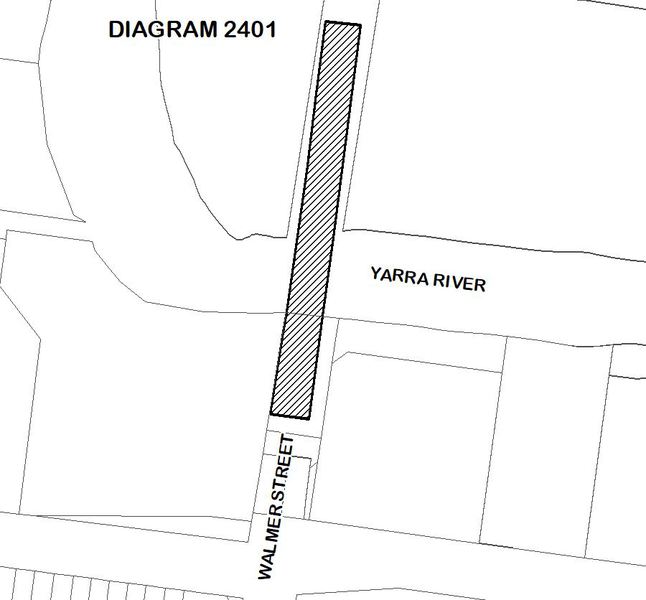
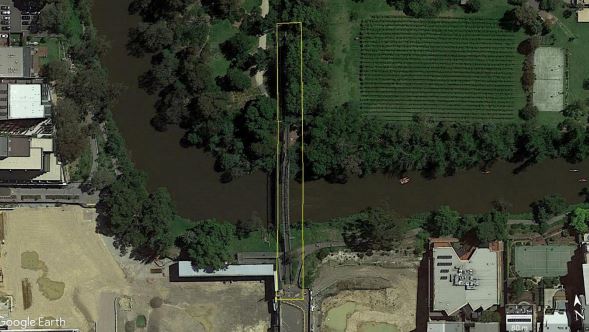
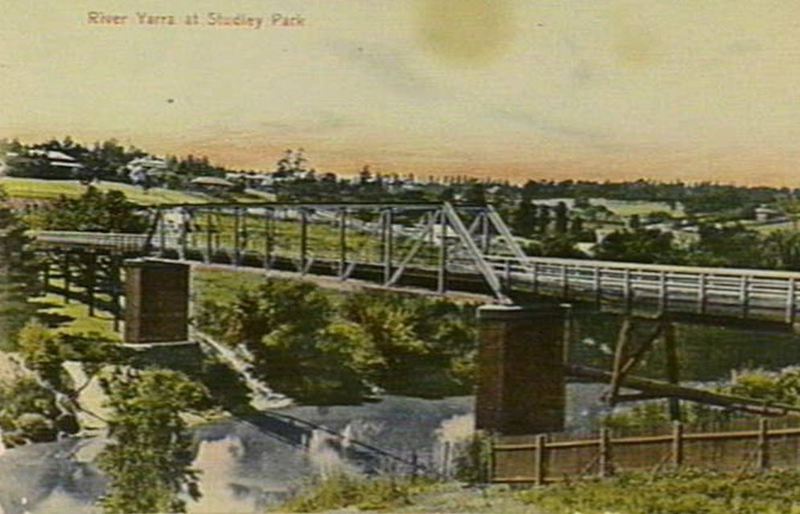
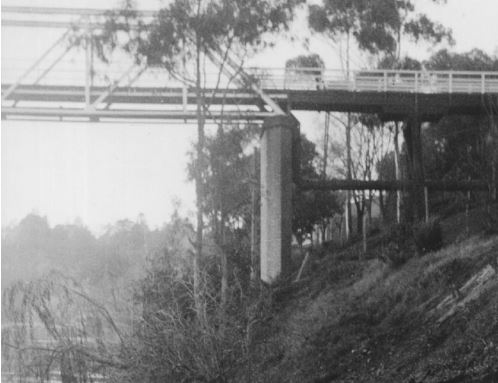
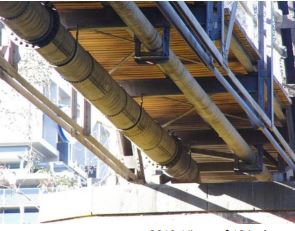
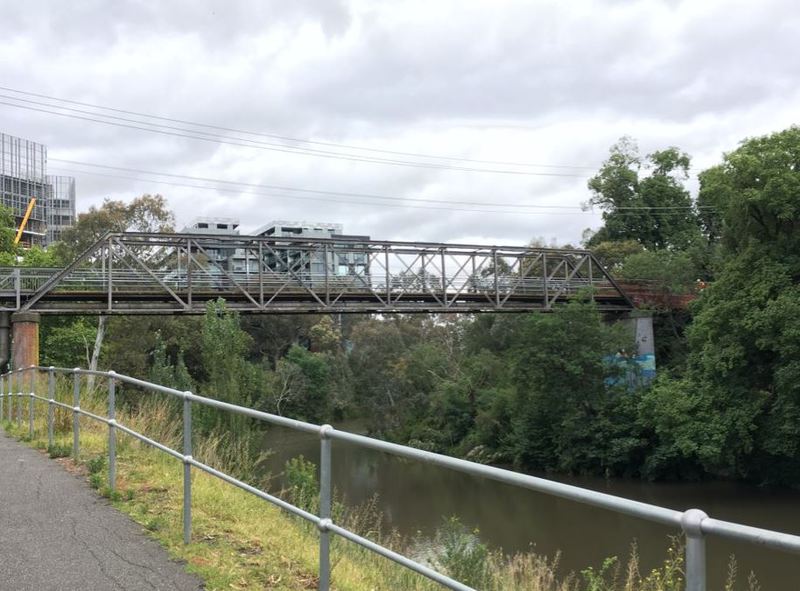
On this page:
Statement of Significance
Walmer Street Bridge is located on Wurundjeri Country.
What is significant?
The Walmer Street Bridge including the central Pratt truss bridge span, brick piers on both sides of the river and all the surviving 18-inch wrought iron pipe. The fabric associated with the north and south approach spans is not significant.
How is it significant?
The Walmer Street Bridge is of historical significance to the State of Victoria. It satisfies the following criterion for inclusion in the Victorian Heritage Register: Criterion A Importance to the course, or pattern, of Victoria’s cultural history.
Why is it significant?
The Walmer Street Bridge is significant at the State level for the following reasons: The Walmer Street Bridge is historically significant as a surviving remnant of the Dight’s Falls Scheme which conveyed fresh water from the Yarra River near Dight’s Falls to the Royal Botanic Gardens. The Dight’s Falls Scheme was the Garden’s primary source of fresh water from the 1890s to the 1930s and was key in ensuring the survival of the Gardens when other sources proved unreliable. The scheme also supplied water for other important purposes including powering hydraulic lifts in central Melbourne. The Walmer Street Bridge was constructed as an integral part of the scheme and is a substantial and highly visible surviving remnant.
(Criterion A)
Show more
Show less
-
-
WALMER STREET BRIDGE - History
Irrigation of the Royal Botanic Gardens
Supply of fresh water to irrigate the Melbourne Botanic Gardens (the Royal designation was added in the 1950s) had been a challenge since they were established in 1846. Initially, water was hand carted from the Yarra River near the Gardens. In the 1850s Ferdinand von Mueller, Director of the Gardens, established rudimentary systems to draw water from the Yarra River near the Gardens. In 1864, the Gardens were permitted to draw water from Melbourne’s main metropolitan supply provided by the Yan Yean system. This supply was unreliable and the demands placed on the system by the Gardens impacted on the domestic supply for the surrounding suburbs. In the late 1860s, a steam engine was installed on the banks of the Yarra River near the Gardens to draw water for the purpose of irrigation. Access to the Yan Yean supply was cut off. In the 1870s, William Guilfoyle, newly appointed Director of the Gardens, installed a system with a more powerful steam engine which filled a reservoir within the Gardens. With the removal of falls and reefs along the lower reaches of the Yarra River in the 1880s the river water became increasingly saline. A source of fresh water could no longer be found close to the Gardens and the saline water damaged the Gardens' plants. In 1889, the government agreed to a scheme to draw fresh water from near Dight’s Falls to supply the Gardens as well as several private businesses.
Dight’s Falls Scheme
A system to bring fresh water from the Yarra River near Dight’s Falls was chosen as the preferred scheme to supply the Botanic Gardens with fresh water. Engineer William Thwaites of the Public Works Department designed the scheme. In 1889 construction of the system began. It included a pumping station on the Kew side of Dight’s Falls, that drew water from just below the falls, and a rising main that carried water to a reservoir on the natural rise of Studley Park. A gravity fed system took water from the reservoir on a route that passed through Kew, across the Yarra via the Walmer Street Bridge, underground through Richmond, across the river at Anderson Street and on to the reservoir in the Botanic Gardens that had been established by Guilfoyle. By May 1891 the system was largely complete, though the Walmer Street Bridge was yet to be finished. The pumping station was inaugurated at a ceremony in May 1891. The system was not fully operational until 1892. It provided a reliable supply of water to the Botanic Gardens until the 1930s when the system was attached to the mains supply at Richmond. Parts of the system including the reservoir and pipes remained in use until the 1950s. In the 1960s the Pumping Station at Dight’s Falls was demolished and the reservoir at Studley Park was filled in.
Construction of Walmer Street Bridge
A river crossing by punt was in use in the vicinity of Walmer Street from the 1850s. When Walmer Street was chosen as the point at which the water pipe for Dight’s Falls Scheme would cross the Yarra River, it was proposed to provide a footbridge as well. The cost was shared between Kew and Richmond Councils and the Public Works Department. The 18-inch wrought iron pipe and bridge truss were produced by prominent local manufacturer Mephan Ferguson. In July of 1891, when almost complete, the original bridge was washed away by flooding. After a period of debate between the councils and the Minister of Public Works, who for a time refused to re-erect the bridge, it was re-built in 1892 and the Dight’s Falls System became operational. The piers of the second bridge were built further back from the river banks and it was built to a greater height.
Melbourne Hydraulic Power Company
Hydraulic powered lifts and hoists appeared in Melbourne from the 1870s. The price of land in central Melbourne increased with the boom of the 1880s and provided an incentive for building taller buildings. The Otis Elevator company had a presence in Melbourne in the 1880s and encouraged owners to install hydraulic passenger lifts in new buildings, pushing building heights to eight floors and beyond. The Yan Yean water supply was insufficient to power the lifts and they were generally powered by expensive in-house systems. The Melbourne Hydraulic Power Company (MHPC) was established in 1887 with the aim of providing an alternative public source of hydraulic power. Several pumping stations were established across Melbourne and water was drawn from the Yarra River near Queens Bridge. The increasing salinity of the river was deemed to impact on the MHPC’s riparian rights and the company was offered access to fresh water supplied by the Dight’s Falls Scheme. MHPC was connected in 1893 and by 1897 the scheme was powering hydraulic lifts in over a hundred buildings in central Melbourne. Hydraulic lifts continued to dominate in Melbourne until World War I, after which electric lifts came to dominate. There are very few surviving physical elements of the MHPC’s system. The Overhead Water Tank (VHR H2117) on Spencer Street, Melbourne was used to generate power for the system and is in included in the VHR.
Brookes and Currie Paper Mill
The Dights Falls Scheme also supplied the Brookes and Currie paper mill near Princes Bridge. The mill, first established by Samuel Ramsden in the 1860s, was reliant on a supply of fresh water drawn from the Yarra River near its Flinders Street location. A concern that the government had infringed the firm’s riparian rights by removing the Falls near Queens Bridge resulted in a proposal that they be connected to the Dight’s Falls Scheme.
Key References
Newspapers
“The Botanical Gardens” The Age 13 April 1889.
“The Dight’s Falls Pumping Scheme” The Age 4 June 1891.
“The Dight’s Falls Water Scheme” The Argus 22 May 1891.
“Walmer Street Bridge” The Argus 10 September 1891.
Websites
“Ferguson, Mephan (1843–1919)”, Australian Dictionary of Biography
“Pratt Truss”, Garrett’s Bridges
“The Timber Truss Bridge Book”, NSW Roads and Maritime
“Thwaites, William (1853–1907)”, Australian Dictionary of Biography
Reports
Context (2007) Victorian Water Supply Heritage Study
Books Pescott, R. T. M. (1982)
The Royal Botanic Gardens Melbourne: a history from 1845 to 1970.
Articles Lamb, Rohan (1996) “Under Pressure: The Evolution of the Water Supply System of the Royal Botanic Gardens” Victorian Historical Journal 67:1.
Pierce, Miles (2009) “The Melbourne Hydraulic Power Company and public hydraulic power systems in Australia” Australian Journal of Mechanical Engineering 7:2WALMER STREET BRIDGE - Permit Exemptions
General Exemptions:General exemptions apply to all places and objects included in the Victorian Heritage Register (VHR). General exemptions have been designed to allow everyday activities, maintenance and changes to your property, which don’t harm its cultural heritage significance, to proceed without the need to obtain approvals under the Heritage Act 2017.Places of worship: In some circumstances, you can alter a place of worship to accommodate religious practices without a permit, but you must notify the Executive Director of Heritage Victoria before you start the works or activities at least 20 business days before the works or activities are to commence.Subdivision/consolidation: Permit exemptions exist for some subdivisions and consolidations. If the subdivision or consolidation is in accordance with a planning permit granted under Part 4 of the Planning and Environment Act 1987 and the application for the planning permit was referred to the Executive Director of Heritage Victoria as a determining referral authority, a permit is not required.Specific exemptions may also apply to your registered place or object. If applicable, these are listed below. Specific exemptions are tailored to the conservation and management needs of an individual registered place or object and set out works and activities that are exempt from the requirements of a permit. Specific exemptions prevail if they conflict with general exemptions. Find out more about heritage permit exemptions here.Specific Exemptions:It should be noted that Permit Exemptions can be granted at the time of registration (under section 38 of the Heritage Act 2017). Permit Exemptions can also be applied for and granted after registration (under s.92 of the Heritage Act).Under section 38 of the Heritage Act 2017 the Executive Director may include in his recommendation, categories of works or activities which may be carried out in relation to the place or object without the need for a permit under Part 5 of the Act. The Executive Director must not make a recommendation for any categories of works or activities to be permit exempt if he considers that the works or activities may harm the cultural heritage significance of the place or object. The following permit exemptions are not considered to cause harm to the cultural heritage significance of the Walmer Street Bridge.General ConditionsGeneral Condition 1All exempted alterations are to be planned and carried out in a manner which prevents damage to the fabric of the registered place or object.General Condition 2Should it become apparent during further inspection or the carrying out of works that original or previously hidden or inaccessible details of the place or object are revealed which relate to the significance of the place or object, then the exemption covering such works shall cease and Heritage Victoria shall be notified as soon as possible.Specific Permit ExemptionsGeneral- Inspection, repair and maintenance of non-original physical fabric, being all fabric other than the two brick piers and bluestone coping, the portion of the bridge comprised of the Pratt iron truss bridge and 18-inch wrought iron water pipe in a manner that does not change the appearance of the heritage place.
- Inspection, repair or maintenance of original physical fabric that is damaged or deteriorated and is beyond further maintenance, in a manner that is undertaken to the same details, specifications and materials and does not have a negative impact on the cultural heritage significance of the place and does not change the appearance of the heritage place.
- Painting of previously painted surfaces, but not painting that would constitute advertisement.
- Works or activities, including emergency stabilisation (including propping) of the north and south approach spans, necessary to comply with Australian Standards or other relevant statutory standards or requirements and/or secure safety in an emergency where a structure or part of a structure has been irreparably damaged or destabilised and poses a safety risk to its users or the public. The Executive Director, Heritage Victoria, must be notified within seven days of the commencement of these works or activities.
- Cleaning including the removal of surface deposits, organic growths or graffiti by the use of low pressure water (less than 100 psi at the surface being cleaned) and neutral detergents and mild brushing and scrubbing.
- The erection of temporary security fencing, scaffolding, hoardings, signage or surveillance systems to prevent unauthorised access or secure public safety which will not adversely affect significant fabric of the place. Such temporary structures should not be attached to the piers, truss or pipe and be of limited duration.
Landscape elements- The processes of landscape maintenance including pruning, mulching, removal of dead shrubs, planting, disease and weed control and maintenance to care for existing plants.
- Subsurface works involving the installation, removal or replacement of drainage systems or other services provided there are no visible above ground elements.
- Works and activities associated with the management of possums and vermin.
- Maintenance and care of trees and removal or pruning of dead or dangerous trees to maintain safety.
- Maintenance and repair of existing paving and other hard landscaping elements.
Notes- All works should ideally be informed by Conservation Management Plans prepared for the place. The Executive Director is not bound by any Conservation Management Plan, and permits still must be obtained for works suggested in any Conservation Management Plan.
- Nothing in this determination prevents the Heritage Council from amending or rescinding all or any of the permit exemptions.
- Nothing in this determination exempts owners or their agents from the responsibility to seek relevant planning or building permits from the relevant responsible authority, where applicable.
-
-
-
-
-
ABBOTSFORD CONVENT
 Victorian Heritage Register H0951
Victorian Heritage Register H0951 -
FORMER GROSVENOR COMMON SCHOOL
 Victorian Heritage Register H0654
Victorian Heritage Register H0654 -
THE HAWTHORNS
 Victorian Heritage Register H0457
Victorian Heritage Register H0457
-
"1890"
 Yarra City
Yarra City -
'BRAESIDE'
 Boroondara City
Boroondara City -
'ELAINE'
 Boroondara City
Boroondara City
-
-












